On the Wisdom of Dumping Contaminated soils in the Shawnigan Lake Watershed
Background
On August 21, 2013 the Ministry of Environment (MOE) granted South Island Aggregates Ltd. (SIA)/ Cobble Hill Holdings (CHH) a 50-year permit to receive up to 100,000 tons of contaminated soil annually (a total of five million tons). The proposed location of the site for the contaminated soils is the SIA quarry located at 640 Stebbings Road (Lot 23 owned by CHH). This is located off South Shawnigan Lake Road between Shawnigan Lake and Highway 1. SIA proposed to back fill their quarry with contaminated soils while they continued to blast for new aggregate material. The permit was granted subject to “requiring complete containment of the soils to be introduced into the quarry.”
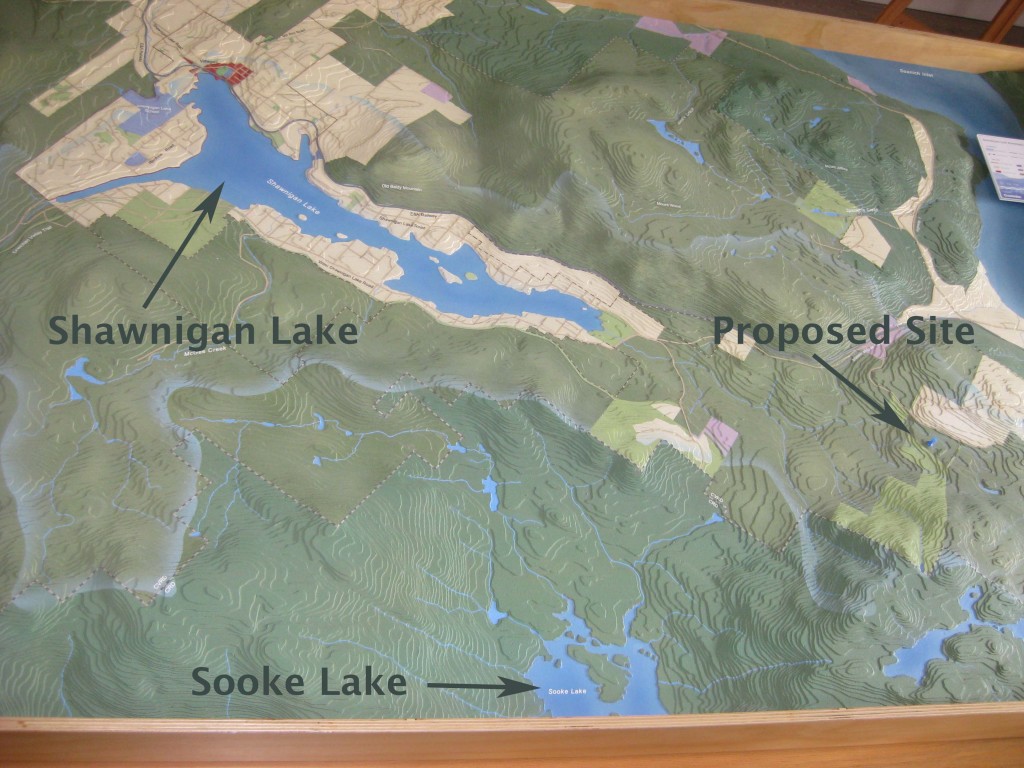 Figure 1: Photograph of a topographic map showing the locations of Shawnigan Lake, Sooke Lake and the proposed site for the contaminated soils.
Figure 1: Photograph of a topographic map showing the locations of Shawnigan Lake, Sooke Lake and the proposed site for the contaminated soils.
Five days later, the Shawnigan Residents Association (SRA) appealed the Ministry’s decision to issue SIA a permit. They cited five reasons for their appeal. The first three were:
1) The testing and assessment of the suitability of the site’s geology and hydrogeology was inadequate and incomplete.
2) The monitoring and water treatment plans were deficient.
3) The MOE failed to apply the appropriate test for the issuance of the Permit in that it failed to:
(a) ascertain the degree of scientific uncertainty about the hydrogeology, water monitoring and treatment technologies and plans;
(b) in view of the uncertainties, identify the degree of risk that the facility will not succeed in permanently containing the contaminants and toxins in the five million tons of contaminated soil to be deposited at the site.
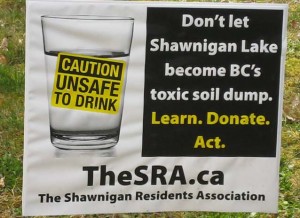 Initially, I was reluctant to wade into this issue. But as time rolled on I started to receive a number of emails and letters from concerned constituents who had vacation properties on Shawnigan Lake.
Initially, I was reluctant to wade into this issue. But as time rolled on I started to receive a number of emails and letters from concerned constituents who had vacation properties on Shawnigan Lake.
The proposed location of the contaminated soil site (Figure 1) is at an elevation above both Shawnigan Lake, the water source for about 5,000 local residents who draw directly from the lake, as well as Sooke Lake, the reservoir for Greater Victoria’s water. An additional 7,000 or so residents get their potable water from within the Shawnigan Lake watershed. Surface water runs into Shawnigan Lake while the path taken by groundwater is plagued with great uncertainty.
In its application for a stay pending a decision from the Environmental Appeal Board, Shawnigan Residents Association noted expert testimony from hydrogeologist Dennis Lowen that argued: “The site is not suitable for a landfill”. They further submitted:
“The ground on which the landfill is to be located is fractured bedrock… The site itself is an active rock quarry… The quarry has only been 4% mined, so blasting and excavating is ongoing… backfilling will be accomplished using contaminated soil instead of clean fill …the site would not, for example, be acceptable for a secure landfill under Hazardous Waste Legislation.”
On September 13, 2013, the Cowichan Valley Regional District also filed an appeal to the Environmental Appeal Board. They too took a very strong position against the proposed contaminated soils site. Amongst a variety of other concerns, they argued that:
a. There is a divergence of professional opinion and significant uncertainty in the geology and hydrogeology of the area and the associated risks to drinking water resources.
b. The characterization of the geology and hydrogeology of the area is based on a limited amount of data and a limited number of wells and boreholes not evenly distributed around the property and surrounding area.
c. The design of the proposed contaminant soil treatment facility and landfill facility does not adequately ensure that contaminated soil and ash or the associated effluent will not adversely impact drinking water resources or the environment.
Professional Reliance
In 2001 after the BC Liberals were elected to their first term, they began a comprehensive core review to cut the size of government. Premier Campbell asked all government departments to prepare scenarios as to what it would look like with 20%, 35% and 50% cuts to spending. As a direct consequence of government downsizing, technical expertise within the civil service became a casualty. Instead of having technical expertise in house, the government moved towards wide scale use of Professional Reliance in the permitting process. Under the Professional Reliance approach, the Ministry relies on the judgment and expertise of qualified experts hired by a project proponent.
What is particularly important to note is that in March 2014, the Office of the British Columbia Ombudsperson released a scathing report criticizing the Professional Reliance model with respect to streamside protection and enhancement areas. The report, entitled The Challenges of Using a Professional Reliance in Environmental Protection – British Columbia’s Riparian Areas Regulation made 25 recommendations, 24 of which the government agreed to accept. But this acceptance came almost a year after the Ministry of Environment granted SIA their permit.
My own personal view is that the government’s approach to follow the Professional Reliance model is fraught with difficulties. The role of the government is to protect the public interest. When government is making decisions solely based on a project proponent’s expert opinion, it is very troubling. Imagine a judge in a court of law only listening to the expert opinion on one side of a case (plaintiff or defendant) and not allowing expert opinion to be submitted from the opposing side.
As such, the concerns of both the CVRD and the SRA seem particularly relevant in light of the fact that they themselves brought in expert testimony that contradicted the project proponent’s evidence.
638 Stebbings Road
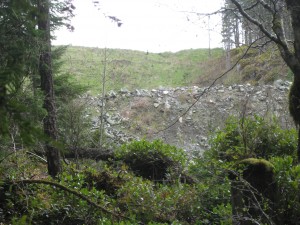 The property located at 638 Stebbings Road (known as Lot 21) is owned by 0782484 B.C. Ltd. and has been in use for quite some time as a fill site. A photograph of the northern boundary wall of deposited soils is shown to the right. This photograph was taken from CVRD Parkland on the north side of Shawnigan Creek. Lot 21 is located immediately adjacent to Lot 23. In November 8, 2013 the Environmental Appeal Board granted a stay in proceeding to the SRA and CVRD until such time as their full appeal was heard. In their decision, the Environmental Appeal Board noted a number of serious concerns regarding Lot 21. For several years, soil has been dumped Lot 21 for later use to backfill the quarry in lot 23.
The property located at 638 Stebbings Road (known as Lot 21) is owned by 0782484 B.C. Ltd. and has been in use for quite some time as a fill site. A photograph of the northern boundary wall of deposited soils is shown to the right. This photograph was taken from CVRD Parkland on the north side of Shawnigan Creek. Lot 21 is located immediately adjacent to Lot 23. In November 8, 2013 the Environmental Appeal Board granted a stay in proceeding to the SRA and CVRD until such time as their full appeal was heard. In their decision, the Environmental Appeal Board noted a number of serious concerns regarding Lot 21. For several years, soil has been dumped Lot 21 for later use to backfill the quarry in lot 23.
My site visit to the region
On the afternoon of Thursday April 2, 2015, I visited the region with Shawnigan Lake Area Director Sonia Furstenau. Together with a few other Shawnigan Lake residents, we hiked around Lots 21 and 23 on parkland owned by the CVRD. I took this opportunity to take a number of photographs. More importantly, I took the opportunity to collect water samples.
 Figure 2: Google Earth image showing the location of the SIA rock quarry and the sites where water samples were collected.
Figure 2: Google Earth image showing the location of the SIA rock quarry and the sites where water samples were collected.
The quarry located on Lot 23 (shown in Figure 2 and pictured in the banner image above) is bordered to the west by CVRD parkland and to the north by Lot 21. Our journey took us from Stebbings Road along a parkland covenant on the south side of the quarry to the parkland immediately to the west. We hiked in parkland along the western edge of the quarry and made our first stop at the northwest corner of Lot23 where the photographs below were taken. At this location there exists a pond of water (top) that drains (bottom) eventually into Shawnigan Creek.
Figure 3: Photographs taken from the northwest corner of lot 23 where there exists a pond of water (top) that eventually drains (centre) into Shawnigan Creek.
From this point we continued north along the western edge of Lot 21. Here it was readily evident that fill containing building materials was prevalent on the Lot 21 property. In fact, a significant amount of fill had over run Lot 21 and was on the neighbouring parkland. As we passed through the area I took a number of picture illustrating the type of building material that was present. A few examples are shown in Figure 4.
Figure 4: Photographs taken on CVRD land showing presence of building materials.
As evident in Figure 4, we discovered rebar, piping, concrete, asphalt, tiles, and even a tire. There seemed to be a large amount of fill in the form of building material on Lot 21.
Analysis of Water Samples
It is relatively straightforward to determine metal contents in runoff waters using an inductively coupled plasma mass spectrometry (ICPMS). Given the visible presence of steel products on the surface of the neighbouring CVRD parkland, I decided to collect water samples from two locations.
The first location (Site 1 in Figure 2 and denoted Plat in the analysis tables) was a relatively flat area that had standing water present at the surface. The second location (Site 2 in Figure 2 and donate Outflow in the analysis tables) was collected at the location where Lot 21 runoff entered Shawnigan Creek.
Figure 5: Photographs showing me collecting the water samples: Site 1 (left) and Site 2 (right).
The water flowing into Shawnigan Creek is orange (Figure 6) indicating an abundance of iron in solution.
Figure 6: Photographs of the water that runs from the north end of Site 21 into Shawnigan creek.
I passed the sample to my University of Victoria colleague Dr. Jay Cullen who in turn asked the UVic ICMPS Lab Manager, Dr. Jody Spence, if he would be able to analyse the samples. To process the samples the bottles were vigourously shaken, and the contents divided into two. One of the samples was filtered; one was not. Then 1 mL of environmental grade Nitric Acid was added to the unfiltered portion and left to sit overnight before analysis (this oxidizes and solubilizes more labile components of the precipitate that had formed). For the filtered portion, Dr. Spence used some sample to pre-rinse a clean syringe (all plastic, no rubber), and then filtered about 25 mL of sample through a 0.45 micron disposable filter. To this he added 0.5 mL of Nitric acid and let it sit overnight as well.
The results of the analysis are available in pdf format. All units in this table are in μg/L (micro gram per litre).
Schedule 6 of the Contaminated Sites Regulation of the Environmental Management Act lays out water standards for aquatic life, irrigation, livestock and drinking water. I will only concentrate on the drinking water standard although others may wish to compare my water results for aquatic life standards. As noted in Schedule 6 “Drinking water standards are for unfiltered samples obtained at the point of consumption.”
What is readily apparent from the analysed data is that the iron (Fe) levels fail drinking water standards locally. Manganese (Mn) levels are also high. These levels are almost certainly associated with the presence of buried steel (rebar, building materials etc.) on Lot 21. Nevertheless, by the time the water gets into Shawnigan Lake it will be so diluted that it would no longer fail these standards.
What is also important to note is that I have yet to analyse the water for hydrocarbon content. The presence of asphalt throughout the fill area would suggest that one might indeed expect to find hydrocarbons in the outflow.
Summary
What is apparent to me is that there are substantial amounts of building materials that have been placed on Lot 21. There is clear evidence that runoff from this site fails drinking water standards at the point of entry with Shawnigan Creek. And visually, this water looks nothing like any other water in nearby surface and running water. Missing from my analysis is an examination of hydrocarbon contents in the waters. I’ll save that for a later date.
There is conflicting evidence between the expert opinion provided as part of SIA’s application for a permit and that obtained by Shawnigan Resident’s Association. Herein lies the critical problem with the entire permitting process. The Professional Reliance model for project permitting in use in British Columbia is inherently flawed. No matter what project is seeking approval, when the government bases its decision on the professional advice provided by a project proponent, there will always be public concern. In fact basing approval decisions on the Professional Reliance Model makes it difficult, if not impossible, for a project to earn a social license to proceed.
The role of government is to protect the public interest while at the same time giving industry certainty with respect to the project approval process. My own view is that in order for both public and industry interests to be served transparently and fairly, British Columbia should move away from the Professional Reliance Model and instead create arms length and independent expert oversight panel(s). This can be accomplished by expanding in-house government technical expertise and using that expertise to set up independent oversight of a proponent’s project plan, paid for by the proponent. In addition, the Office of the British Columbia Ombudsperson report mentioned above and entitled The Challenges of Using a Professional Reliance in Environmental Protection – British Columbia’s Riparian Areas Regulation outlined a number of ways of improving the Professional Reliance model.
So how do we move forward from here? It makes little sense to me to dump contaminated soils in the Shawnigan Lake watershed. In addition, there are sufficient uncertainties in ground water processes/flow in the region that I don’t believe it is wise to place the contaminated soils at an elevation higher than nearby Sooke Lake (the source of Victoria’s drinking water). While overall risk may be small, it certainly is not zero and so it would be prudent to apply the precautionary principle in light of the stakes involved.
Instead, perhaps one of the three existing sites owned and operated by Tervita on Vancouver Island could take the contaminated soils. One is in the Highlands, one is in Cumberland and one is near Port McNeill. Tervita has a long history of successfully operating contaminated soil sites. If additional capacity is needed, then let’s start the process over again and search for a different location. But this time either follow the advice of the Ombudsperson’s office or establish and independent panel to oversee the permitting process.
Postscript
I discussed this issue further on CBC radio with Gregor Craigie on Earth Day (April 22, 2015).

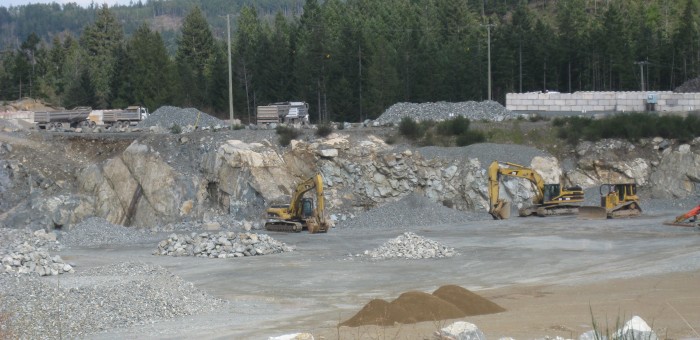
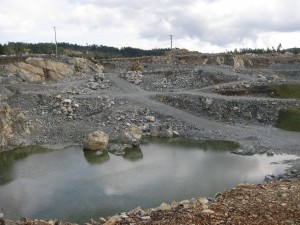
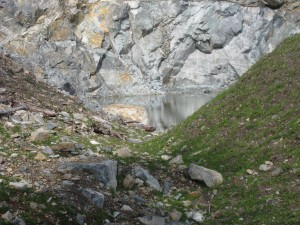
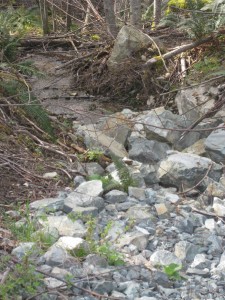
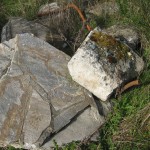

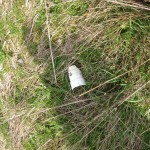
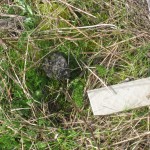
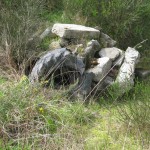
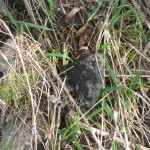
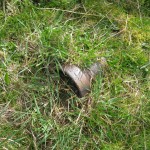
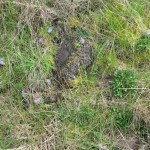
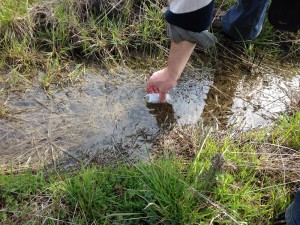
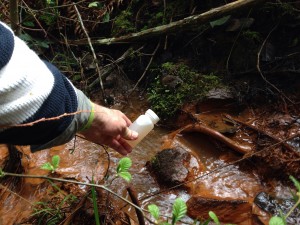
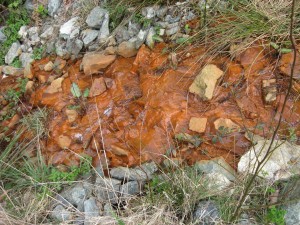
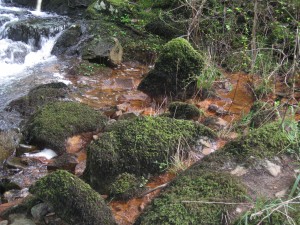



18 Comments
Amazes me that this polluting goes on and it’s time the people held the Gov responsible .Giving a polluting company a 50 year permit to pollute the drinking water of a town .Time to sue the Gov for (Crimes against the people ) because this is what they are doing .Poisoning the water that people have to drink
Use link attached to see a video about the SIA and Mary Polak: https://m.youtube.com/watch?v=nEPQjRvnY28
Thank you so much for your very thorough and visual support for this issue. None of my letters to the ministries, or investigative media have received anything other than automated responses.
I was incensed to see the picture of the cement, rebar and especially the tire that have been so ignorantly dumped in our watershed, spilling over onto our beautiful parkland. There are ways to recycle all of those waste materials and a very competently run recycle depot on Fisher road in Cobble Hill does just that. The fact that this garbage was allowed to be dumped there speaks volumes as to the carelessness of the monitoring done by SIA and CHH. How the EAB believes these companies can contain, treat and monitor the amount of contaminated soil the permit allows for makes me wonder about the intelligence of those who have the authority to make these decisions that affect us. Obviously neither the decision maker, Herbert Bunce, or the EAB panel members have visited the site as you did.
For almost 40 years now, a volunteer run project by the Mill Bay and District Conservation Society, with support and assistance of the Dept. of Fisheries and Oceans, have used the creeks and Shawnigan Lake in the success of restoring Pacific Coho in our region to greater return numbers than ever.
If the Ministry of Environment doesn’t care about the future safety of the drinking water of thousands of their electorate, perhaps the negative impact to BC’s salmon will encourage them to rethink this permits approval. Not only does the permit need to be revoked, but SIA and CHH must be charged with the responsibility for cleaning up the mess they’re already shamefully responsible for.
I wonder if their mining permit shouldn’t be revoked as well?! Since they have already shown delinquency in that endeavor. Then fill will become unnecessary.
The Ministry of Environment regulated permit process has not served the public interest from the beginning; it has serviced only the commercial interest of one party.
The federal government is concerned about the risk to drinking water from their contaminated sites across Canada. See http://www.cbc.ca/news/politics/contaminated-sites-cleanup-to-cost-billions-more-budget-office-says-1.2604939. While the permit provides a local disposal solution that may meet the federal government’s need for cleanup of multiple contaminated sites in the area, it transfers the risk of contamination to the Shawnigan Lake watershed. This is not aligned to the federal government’s need for risk reduction.
Risk mitigation in the permit is limited to the engineered solution; there is no mitigation or remedy for a possible failure in the engineered solution or human error. Contamination in the watershed cannot be remediated
Self-monitoring and reporting is a ridiculous conflict for the scale of public risk related to the performance of the solution and the applicant.
The Minister of Environment needs to concede the failure of Ministry regulations and processes to serve the public interest and fix the problem. Only in government can the head of a major enterprise not take direct responsibility for an outcome delivered by that enterprise. Who created statutory processes that do not serve the public interest?
Overall, this is governance that does not serve the electorate — it is government at its worst.
The ministry is aware that SIA only applied for the permit after contaminated soil was accidently dumped on their site and they decided to charge more for the load. Then the geniuses said, hey why don’t we apply for a permit, double the money double the fun and we can fill our mine with the stuff at the same time.
We will make a fortune and if their is a disaster, well we can just fold the company. The company the hired to support their claims didn’t even show at the EAB hearing that I attended. Imagine how the scientists representing the CVRD and SRA had a completely different view of the site’s suitability. I mean just look at a map, shit goes downhill. SIA has a past record of not responding to ministry requests and I am sure that won’t change. Actually they are to be self regulating with their 225K deposit to cover any environmental damage. Last time I looked it could cost about a quarter of that to clean up a leaky oil tank, but not to worry that’s more than enough for 50 million TONS of contaminated waste. Well when even past employees speak about the folly of this decision and how SIA can not be trusted one wonders how the EAB ever thought this was a good idea. Well not too worry, lawsuits will be forthcoming, from class action to supreme court and trust me the citizens aren’t fading off quietly into the night. PS, wonder if the Environment Minister ever heard of the magna carta, the people folks, all of the community is against this and recognize the environmental hazards of this site. SIA couldn’t even keep the bathroom that had potable water safe from contamination as the well on site no longer is safe to drink from. These are the same people that will ensure our drinking water is safe. Acceptable Risk, tell you what I would love to show the EAB and the Environment Ministry a little acceptable risk myself. Man am I ever pissed off.
I find a lot of what Dr. Weaver says really hard to follow. He quotes from some of the early initial documents that were for the start-up of the appeal. It sure looks like he did not read the actual decision. It is full of the precautionary principle.
My read of the decision is that the Ministry and the Board did not rely on the application, or the professional reliance of the permit people’s engineers.
Also, this whole water sampling thing is really strange. The governments own website says iron and manganese is natural. And maybe not a health thing at all. Here is what it says:
“What are iron and manganese?
February 2007
Iron and manganese are metallic elements present in many types of rock. Iron has the symbol “Fe” and manganese has the given symbol “Mn.” Both are commonly found in water and are essential elements required in small amounts by all living organisms. Concentrations of iron and manganese in groundwater are often higher than those measured in surface waters.
The Aesthetic Objective (AO) for iron in drinking water is less than or equal to 0.3 milligrams per litre (mg/L) while the Aesthetic Objective for manganese in drinking water is less than or equal to 0.05 mg/L. The taste and smell of manganese or iron at concentrations above the drinking water guidelines may be noted by some water users.
What are the known sources of iron and manganese?
The most common sources of iron and manganese in groundwater are naturally occurring, for example from weathering of iron and manganese bearing minerals and rocks. Industrial effluent, acid-mine drainage, sewage and landfill leachate may also contribute iron and manganese to local groundwater.
What are the environmental health concerns?
At concentrations found in most natural waters, and at concentrations below
the aesthetic objective, iron and manganese are not considered a health risk. Water with a high concentration of iron or manganese may cause the staining of plumbing fixtures or laundry. Manganese solids may form deposits within pipes and break off as black particles that give water an unpleasant appearance and taste. Similarly, iron can collect and block pipes or fixtures and produce colour, taste and rust flakes in water. Both substances can increase the growth of unwanted bacteria that form a slimy coating in water pipes.”
Anyway, Dr. Weaver says there is no way the levels will still be high at the lake. If he is worried about iron, what does he think of the hundreds of docks with iron bolts and rings on them, the hundreds of iron chains holding all these dock in place, that are IN THE LAKE!!
And the asphalt as hydrocarbon contamination??? The last time I was at Shawnigan I seem to recall a huge ribbon of this contaminating hydrocarbon asphalt put there by the government and lots of home owners, in the form of the Shawnigan Lake Raod, and driveways, and launch ramps, almost of it within a couple of hundred feet of the lake. And the rain runs across it every day, and straight in to the lake. So what gives?
Elgin, I think you will agree that Iron is probably the least of anyone’s worries, since the permit gives SIA permission to accept soil containing high concentrations of toxins like Lead, Mercury, Pesticides (including DDT), and PCBs. [see paragraph 67 of the appeal ruling; the list is extensive] Perhaps Dr. Weaver is simply pointing out that things are already leaching from the site and it hasn’t even started to accept toxic fill. Or perhaps he is pointing out that SIA has dumped fill containing building materials all over a park. Maybe the Ministry of Environment should get up there and see exactly what has been dumped on parkland by their new permit holder, who they are counting on to exhibit operational excellence in running this new toxic fill site.
Many of the permitted toxins are extremely dangerous. If you agree that the precautionary principle is defined as, “the precept that an action should not be taken if the consequences are uncertain and potentially dangerous,” then I’m not sure why you are confused. This site is fraught with risk and the Ministry of Environment is trying to make up for a bad location with engineering;
– The quarry sits on top of an Aquifer and next to Shawnigan Creek [paragraphs 47 and 264]
– Any water leaving the site will enter the creek and eventually Shawnigan Lake [50] or possibly the aquifer beneath the site. [466]
– The containment of the site is pretty much reliant on the plastic liners and the water treatment plant, since there is significant doubt that the bedrock under the site is impermeable. [475-477]
– SIA is going to continue blasting, even after they start installing the plastic liners and accepting fill [445]
– The Ministry upheld the permit based on SIA monitoring and operating the site per the conditions of the permit [477]. That monitoring is self-reporting [708].
– SIA has already failed, at least once, to properly treat contaminated water at the site. [542]
Given the nature of the materials that may be stored at SIA’s site and it’s location, the containment has to be perfect. Not only does it have to be perfect now, it has to remain perfect in perpetuity. That is why the site is not suitable… because if things go wrong, it could poison both Sooke Lake and Shawnigan Lake.
As a previous employee of SIA I cannot stress enough the seriousness of stopping this permit. The environmental board has given this permit with the expectation that it will be “self monitored”. This is as smart as leaving a fox to watch the hen house. In my opinion, this is a catastrophe waiting to happen and both the water supply of the Shawnigan Lake district and the Capital Regional District are in jeopardy.
An excellent and, dare I say, brave letter Sheila. Maybe you can shed some light on this, but I’ve always wondered who could have conceived of such a bone headed project in the first place? You would think that someone with even a tiny morsel of common sense would have weighed in at the beginning and thrown XXXX and YYYY out for even proposing such a scheme. It’s frightening to think how a community can be held hostage by 2 guys with such a stupid plan. [AW: names edited out for privacy]
Thank you so much for weighing in on this issue. The support of all MLAs is needed to bring the Province of BC into the 21st century and institute policies that would protect the watersheds – governments are needed to protect people from unscrupulous corporations who can hide behind numbered companies and simply enter bankruptcy protection when huge problems are uncovered 20 years from now, and then walk away with massive profits that have already been distributed to shareholders.
Thank you for speaking about this. As someone who spent 23 days in the appeal court hearings….I know the flaws of this plan. Our watershed is not an ‘acceptable risk’ as the EAB say. I appreciate your testing the water and seeing with your eyes the truth of the boondoggled appeal process.
Let’s stop moving the contaminants and bioremediate on sight with mushrooms and nature. Thank you
Thank you for your very informative article . I have not read a lot of the reports or the 144 ? page decision from the appeal, but appreciate your concise summary and the pictures. I did see the news on TV with pictures of the orange water. One person I spoke to said it was probably pollen from the trees ! . This government seems to disregard anything regarding families and health. I find Christy Clark rude and self-serving. If this site was in the Victoria or Vancouver watershed it would not even been considered. Period. Why, because we are a small area does she think we deserve less. I feel very afraid for the future of our lake and our health.
Let this be the beginning of a new economic paradigm for Shawnigan Lake, indeed, the Cowichan Valley. We have such potential for sustainable forestry, eco/adventure tourism. Our trail infrastructure, and potential to be a world class destination are as immense the personalities and commitment of the very citizens of Shawnigan who have tried to bring this challenge to a just end. That anyone would consider dumping toxic soil in a watershed is 20th century thinking (might even be 19th century!). Shawnigan Lake in the 21st century will be a jewel on Vancouver Island. Let it start with this. Thanks Doctor.
Thank you MLA Weaver for a very comprehensive and we’ll thought out analysis and article.
Will you be pursuing this in the House?
Dr W: thank you for your energy, (dare I say ‘brave’) commitment and diligence in this matter> I have for some time been concerned by the risks inherent to BC’s Professional Reliance Model (PR) as constituted and in particular to the longer term consequences and ultimate direct and indirect costs of remediation to the Shawinigan Lake watershed matter. It is my trust that constant and consistent awareness brought to public and political awareness will in the end cause change to the PRM.
I really appreciate your involvement in our watershed protection. Having an individual with a your credentials re: environmental issues, lends credibility to our cause. It is paramount that Victoria realize that the Sooke Lake Reservoir is also at risk. As you stated ground water runoff is virtually impossible to predict. This is a 2015 issue. Nicola Valley is also in protest of “trucked in wastes” form other locations. This has to stop! B.C. should not stand for “Brought in Contaminants”.
Enjoyed meeting you again last night.
I am so glad that you are speaking out. I see this project as an assault on common sense and the residents of
Shawnigan and Greater Victoria. I have heard the mantra of the Clarke government over and over, “Families First” but this permit puts families last with respect to the health and safety of the local watershed.
Shawnigan Lake is also fed by many springs from the aquifer as well as the creek. I do not know, but it would be likely that similar springs feed Sooke Lake from that aquifer. I don’t think we should have to live with our fingers crossed in Greater Victoria and Shawnigan so that South Island Aggregates can make money! Once the aquifer is poisoned we are all in a grave predicament.
Thank you for this Dr Weaver. We Shawnigan residents have felt like we’re in this fight on our own, it’s good to hear from someone outside our area. This site has been proven to be inherently unsuitable. Even the EAB, in their findings, said that the safety of this project depends on the proper management of the site by SIA. Given your results this doesn’t give me much comfort. And where will SIA be 50 years from now, 100 years from now? Who will manage it then? If the EAB thinks this site is suitable, you have to wonder what it would take for them to consider a site unsuitable.